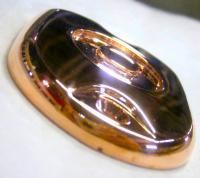 | ||
Copper plating is the process electrolytically plating
Contents
a layer of copper is deposited on the item to be plated by using an electric current.
Three basic types of processes are commercially available based upon the complexing system utilized:
With a higher current, hydrogen bubbles will form on the item to be plated, leaving surface imperfections. Often various other chemicals are added to improve plating uniformity and brightness. Without some form of additive, it is almost impossible to obtain a smooth plated surface. These additives can be anything from dish soap to proprietary compounds.
Limitations
The plating seen in chemistry classes, often obtained with a coin and copper-sulphate bath, is in fact deposition, as opposed to plating. Subjecting the surface to any wear causes the deposit – which is not bonded – to spall. Running such a bath for longer periods, one can readily observe the grainy texture left by deposition, whereas plating results in a smooth surface.
Commercial platers typically use a copper-cyanide solution, which retains a high concentration of copper. However, it is inherently dangerous, due to the highly toxic nature of cyanide.
Effects of bath chemistry on finish
Cyanide based bath chemistry produces a metal finish favored for its diffusion blocking character. If a bright surface is required, such as one required for decoration or soldering upon, an acid bath chemistry is used.
Experimentation with copper plating
Copper pennies are useful in demonstrating the concept of copper plating. A simple lemon bath is used to demonstrate this process. Lemon juice is a natural acid that attacks the oxidized copper-oxygen bond, releasing it from the surface of the pennies. Placement of a metal such as an iron nail in the lemon bath containing suspended copper ions results in a simple copper plating of the iron nail.
